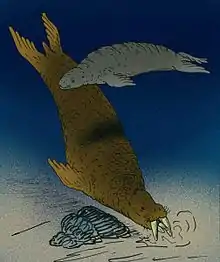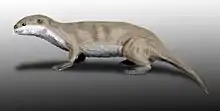Gomphotaria
Gomphotaria pugnax was a species of very large shellfish-eating dusignathine walrus[1] found along the coast of what is now California, during the late Miocene. It had four tusks, with one pair in the lower and upper jaws, and according to wear on the tusks, G. pugnax hammered shellfish open, rather than simply sucking them out of their shells as do modern walruses. In terms of the postcranial skeleton, Gomphotaria and other dusignathine walruses were built more like sea lions than modern walrus. Gomphotaria is a prime example of the extreme diversity that walruses once exhibited.
| Gomphotaria | |
|---|---|
 | |
| Restoration of Gomphotaria pugnax | |
| Scientific classification | |
| Kingdom: | Animalia |
| Phylum: | Chordata |
| Class: | Mammalia |
| Order: | Carnivora |
| Clade: | Pinnipediformes |
| Clade: | Pinnipedia |
| Family: | Odobenidae |
| Genus: | †Gomphotaria Barnes & Rashke, 1991 |
| Type species | |
| Gomphotaria pugnax Barnes & Rashke, 1991[1] | |

Restoration of foraging Gomphotaria pugnax with Dusignathus in foreground
References
- Barnes, L. G. and R. E. Raschke. 1991. Gomphotaria pugnax, a new genus and species of Late Miocene Dusignathine Otariid Pinniped (Mammalia: Carnivora) from California. Natural History Museum of Los Angeles County, Contributions in Science 426:1-16.
| Wikispecies has information related to Gomphotaria. |
| Wikimedia Commons has media related to Gomphotaria. |
This article is issued from Wikipedia. The text is licensed under Creative Commons - Attribution - Sharealike. Additional terms may apply for the media files.


